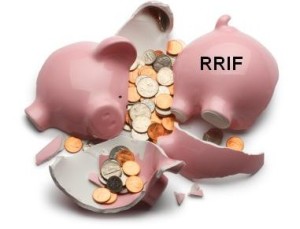
By Mark Seed, myownadvisor
Special to Financial Independence Hub
Unlike some financial experts, I’ve long since touted the merits of making RRSP withdrawals before waiting until the age of 71 for RRSP>RRIF conversion to take effect, when minimum RRIF withdrawal rates kick in.
I’m hardly 70. Not even close (since I just left my 40s)!
Rather, I’ve learned these benefits from others:
While personal finance and investing is always personal, I believe, being forced into managing your portfolio in any way is usually the wrong decision. Successful folks have told me so.
Here are two key experiences from others to share related to RRSP/RRIF withdrawals:
- Unless retirees have very high taxable income already; lots of assets (in the millions) whereby they already stomach paying higher taxes most retirees or semi-retirees should at least consider some RRSP withdrawals in their retirement years to help “smooth out taxation.”
- Beyond RRSP/RRIF income, should any retiree have a workplace pension and/or who may have other significant income streams in retirement (like non-registered investments that generate healthy dividends) they may find themselves in a higher tax bracket as they age into their 70s and 80s, via forced RRIF withdrawals, potentially losing out on government Old Age Security (OAS) benefits.
One of the inspirations for this week’s theme was from this MoneySense article:
I thought the punchline was spot on for this 80-something (Amy), who has a wealth/tax problem to navigate now:
“In summary, Amy, there is no magic bullet to help with your large RRIF account. You will pay a high rate of tax during your life or upon your death on those withdrawals.”
While any retiree’s cashflow objectives will differ, unless you’re in the extreme minority, most successful early and traditional retirees with whom I chat and engage seem to plan WAY ahead on such matters whereby they consistently choose to make some RRSP withdrawals well ahead of when there are forced to.
In making financial decisions before they are forced to, I’ve observed four key benefits:
- Income near-term, from the portfolio they’ve work hard to establish, leveraging income-splitting opportunities with RRSPs > RRIFs in their mid-60s in particular.
- The ability to “smooth out taxation” and be selective to meet both income needs and minimize taxation.
- The opportunity to funnel any strategic withdrawals, to TFSAs (tax-free) or to non-registered assets as they please, the latter which can favour capital appreciation, which is tax-efficient.
- While you can leave your RRIF to your spouse for ongoing tax-deferred reasons, a large RRIF could be subject to over 50% taxation on death. This is not the account to keep for estate planning.
What do you make of RRSP or RRIF withdrawals before you are forced to? Agree or disagree? Happy to read your thoughts in a comment below.
 Mark Seed is a passionate DIY investor who lives in Ottawa. He invests in Canadian and U.S. dividend paying stocks and low-cost Exchange Traded Funds on his quest to own a $1 million portfolio for an early retirement. You can follow Mark’s insights and perspectives on investing, and much more, by visiting My Own Advisor. This blog originally appeared on his site Dec. 16, 2023 and is republished on the Hub with his permission.
Mark Seed is a passionate DIY investor who lives in Ottawa. He invests in Canadian and U.S. dividend paying stocks and low-cost Exchange Traded Funds on his quest to own a $1 million portfolio for an early retirement. You can follow Mark’s insights and perspectives on investing, and much more, by visiting My Own Advisor. This blog originally appeared on his site Dec. 16, 2023 and is republished on the Hub with his permission.

